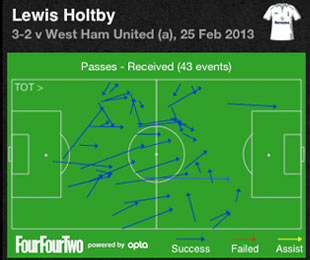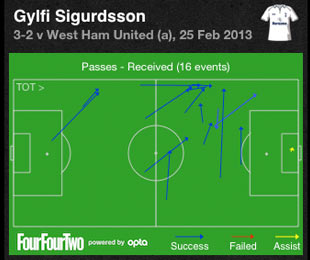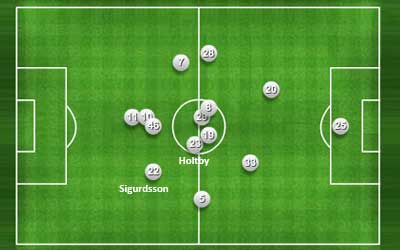Up until we travelled to West Brom, Gareth Bale was the first name on the team sheet, predominantly occupying the left sided role in Andre Villas-Boas’ 4-3-3. The Welshman’s move in to the middle means that the left-sided position has opened up, with both Lewis Holtby and Gylfi Sigurdsson having played their since.
The German came in to the game at West Brom and started in the role at West Ham. The Icelander replaced the German at the Boleyn Ground and started against Arsenal. Both have different qualities, but who is better suited to the role?
Lewis Holtby the passer
Lewis Holtby arrived in January destined to fill the number ten role and become the key we’d been missing to unlock opposition defences. So far he’s only started in the position once against Newcastle, then he switched with Gareth Bale at half time and was brought off 20 minutes later.
What Lewis Holtby brings to the position is that he is more of a trequartista playing wide when he fills the role. He does have an exceptional amount of energy and a willingness to get on the ball, brought about by his time playing as a number ten. This possession hungry nature means that he often goes looking for the ball and comes in to central areas to do so.
If we look at where he received possession against West Ham, you’d have thought that he was playing centrally rather than on the left.

Spurs were trying to create overloads with both Bale and Holtby in central areas, but when the two play together, they can switch positions during the play. This was in evidence against West Brom when the Baggies went down to ten men and both drifted across the formation, combining to score the winning goal.
Lewis Holtby also brings a defensive side to the position, as he can both tackle and intercept the ball in order to recover it. Although he has been drifting in to central areas when we have possession, he does retreat to cover his left back when we lose it.
Gylfi Sigurdsson the attacker
Gylfi Sigurdsson has played the role more as a wide attacking midfielder. He doesn’t play with as much energy as Lewis Holtby, but does bring more discipline to the role.
So far he’s retained width when the ball is in the midfield zone, then looks to move in to more central areas when the play gets towards the opposition box. When he came in to the game for Holtby at West Ham, one thing he immediately brought was a wide position to stretch the Hammers’ defence laterally.

Spurs were pressing, getting up the field and looking for an equaliser on his introduction in to the game. His average position was a lot more advanced and wider than Lewis Holtby for the match, but we do have to take in to context the fact that we were chasing a 2-1 deficit at the time.

Sigurdsson also brings with him an eye for goal that we saw last season with Swansea and has taken a while to appear in a Spurs shirt. He opened his account against the Hammers and should have scored when through 1v1 with Wojciech Szczesny at the weekend.
Whilst Gylfi didn’t score against the Gunners, he did create the opener for Gareth Bale. While he is more of a goalscorer, rather than being a playmaker at the position, he still has an eye for a pass.
Lewis Holtby vs Gylfi Sigurdsson
We can see the difference between the playmaker and the attacking midfielder when we compare the two players’ performances in their time spent in the left-sided role. The Icelander occupying the position for 136 minutes against Arsenal and West Ham, with the German there for 115 minutes against West Brom and the Hammers.
| Gylfi Sigurdsson | Lewis Holtby | |
|---|---|---|
| Mins on pitch | 136 | 115 |
| Goals | 1 | 0 |
| Assists | 1 | 0 |
| Pass received | 3.2 mins | 1.3 mins |
| Chance created | 136 mins | 33 mins |
| Mins per shot | 33 mins | 27 mins |
| Mins per tackle (% won) | 23 mins (33%) | 17 mins (50%) |
| Mins per interception | 67 mins | 66 mins |
.
Each player has spent limited time in the left sided-role, but we can see just how much more Lewis Holtby looks to get on the ball.
Although Sigurdsson played against a tougher opponent in Arsenal, Holtby’s trequartista tendencies to look to receive possession and dictate play come to the fore. The German’s 69 passes received per 90 minutes on pitch (1.3 minutes per pass received) far outweigh Sigurdsson’s 28 (3.2 mins per pass received) in the position regardless of the opposition. Holtby’s chance created every 34 minutes, compared to Sigurdsson’s every 136 minutes also highlight where his strengths lie.
On the other hand, Gylfi’s eye for goal as an attacking midfielder is evident by him taking a shot every 27 minutes and the fact he has registered a goal. He really should have also added a second against the Gunners.
Who should play on the left, Gylfi Sigurdsson or Lewis Holtby?
The decision to whom gets the nod really comes down to the opponent and whether we want a playmaker in the role or a goal-getter.
Lewis Holtby would be better suited to playing against teams who drop off and look to get men behind the ball, where his passing comes to the fore. Gylfi Sigurdsson would be better against sides that are more attack minded, giving him space to operate in.
With Gareth Bale playing in the centre, the left-sided role is up for grabs. While the Welshman continues to do so we could see both Lewis Holtby and Gylfi Sigurdsson getting a chance.
